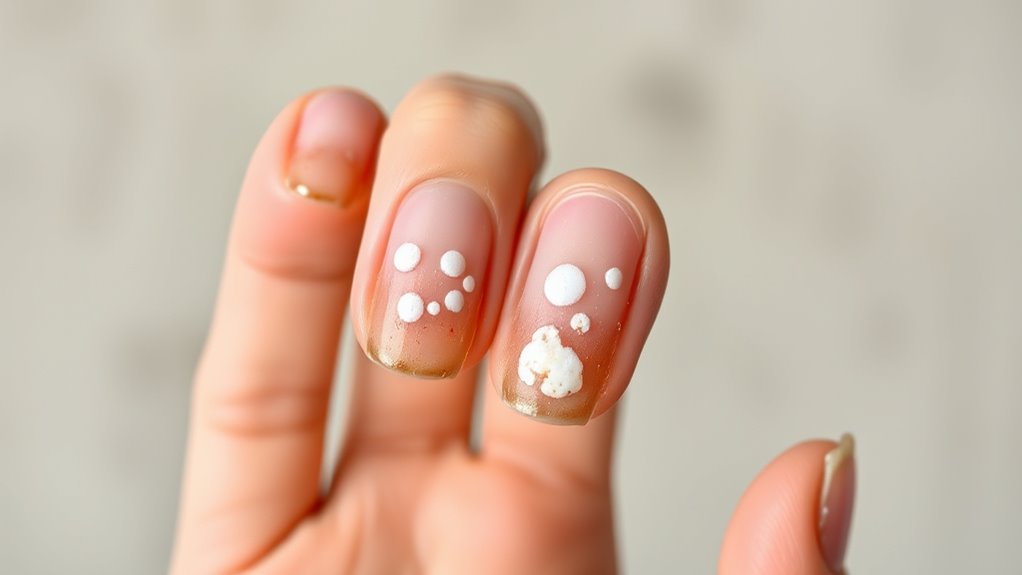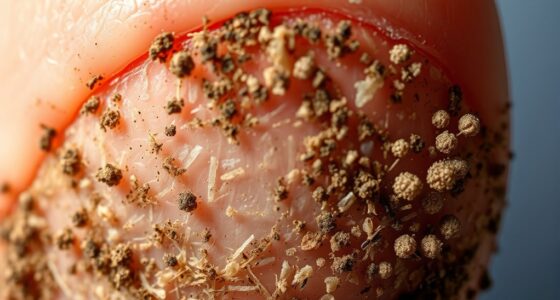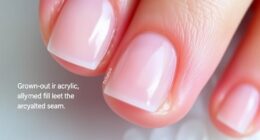White spots on your nails are usually harmless and often caused by minor injuries or air pockets under the surface. They’re not linked to nutritional deficiencies or serious health problems, despite common myths. These spots typically grow out with your nail and fade over time. If you notice persistent or widespread spots, it’s a good idea to get them checked. Curious about what else might be behind these marks? More details await if you keep exploring.
Key Takeaways
- White spots on nails are usually caused by minor trauma or air pockets, and are generally harmless.
- They are often mistaken for nutritional deficiencies, but typically have no connection to calcium or vitamin levels.
- Most white spots grow out with the nail and fade over time, requiring no treatment.
- Persistent or widespread white spots should be checked by a healthcare professional to rule out other conditions.
- Myths linking white spots to serious health problems or deficiencies are false; they are mostly cosmetic.

White spots on your nails are a common concern, but they’re often harmless and easy to understand. Many people worry that these spots signal serious health issues, but in most cases, they are simply a cosmetic concern rather than a sign of an underlying problem. When it comes to nail health, these white spots are usually benign and don’t affect the overall strength or function of your nails. Instead, they’re more about appearance and how you feel about your nails’ look. Understanding what causes these spots can help ease your worries and guide you toward better nail care.
Most white spots are caused by minor trauma or injury to the nail matrix—the area where your nail begins to grow. For example, if you accidentally bump or press on your nail, it can create a small air pocket underneath the surface, resulting in a white spot. These spots tend to grow out with your nail over time and are not a cause for concern. It’s important to note that these spots are not related to deficiencies in vitamins or minerals as some myths suggest, although maintaining a balanced diet can support overall nail health.
Minor trauma to the nail matrix causes white spots that grow out with your nails over time.
There’s also a common misconception that white spots mean you have a calcium deficiency or other nutritional problems. However, this isn’t typically true; most nutritional deficiencies do not present as white spots on nails. Instead, they might cause overall nail weakness, ridges, or brittleness. If you notice persistent or widespread white spots, it’s wise to consult a healthcare professional to rule out other conditions, but most often, these are just cosmetic concerns without health implications.
Other factors like allergic reactions to nail products or fungal infections can sometimes cause changes in nail appearance, but these usually come with additional symptoms such as discoloration, thickening, or crumbling. White spots alone, especially if they’re small and isolated, are rarely linked to these issues. It’s also worth mentioning that some people are simply more prone to developing white spots due to genetics or the natural variability in nail structure.
If you’re worried about the aesthetic aspect, you can gently file down or buff the spots to make them less noticeable. But generally, these spots will grow out and eventually disappear as your nail grows. The key is to maintain good nail hygiene, avoid trauma, and keep your nails moisturized. In most cases, white spots on nails are just a small, harmless annoyance rather than a sign of a serious health concern. Knowing this can help you focus on proper nail care and feel more confident about the health and appearance of your nails.
Frequently Asked Questions
Can White Spots on Nails Indicate a Serious Health Condition?
White spots on your nails usually aren’t a sign of a serious health issue. They often result from minor injuries or nutritional deficiencies, like zinc or calcium. Sometimes, fungal infections can cause similar white patches, but these are typically accompanied by other symptoms. If the spots persist or worsen, it’s wise to consult a healthcare professional to rule out any underlying conditions. Most of the time, these spots are harmless and temporary.
Do White Spots Always Mean Calcium Deficiency?
Ever notice white spots on your nails and wonder if it’s a sign of calcium deficiency? The truth is, they don’t always indicate calcium or nutritional deficiencies. These spots are often harmless and can result from minor injuries or nail trauma. Focusing solely on nail health means understanding that white spots are common and rarely a cause for concern. Keep a balanced diet, but don’t overthink every tiny mark.
Are White Spots Contagious or Can They Spread?
White spots on your nails aren’t contagious or spread misconceptions. They’re usually harmless and caused by minor trauma or zinc deficiency, not infections. Many people worry about contagion myths, but these spots don’t transfer from person to person. You can safely share nails or nail tools without concern. Focus on maintaining good nail health, and don’t stress over these common, benign spots.
How Quickly Do White Spots on Nails Typically Grow Out?
Imagine you’re in the middle of a 1920s dance, and suddenly, a white spot appears on your nail—how fast will it grow out? Usually, nail growth is slow, about 1-2 mm per month. So, it takes roughly 3-6 months for white spots on nails to fully grow out. Spot appearance changes gradually, so patience is key as your nails grow and refresh over time.
Can Lifestyle Changes Prevent White Spots on Nails?
You might wonder if lifestyle changes can prevent white spots on nails. While maintaining good nail hygiene and improving your dietary habits can promote overall nail health, they don’t specifically prevent white spots, which often result from minor injuries or deficiencies. Focus on a balanced diet rich in vitamins and minerals, and keep your nails clean and moisturized. These habits support healthier nails but may not entirely stop white spots from appearing.
Conclusion
Think of white spots on your nails as tiny signs on a map—they might seem mysterious, but they’re often harmless clues rather than hidden treasures. Most of the time, these spots are just minor injuries or mineral deficiencies, not cause for alarm. Don’t let myths cloud your judgment; instead, trust the facts. Keep an eye on your nails, but remember, they’re just small chapters in your body’s story—easy to read once you know what to look for.









